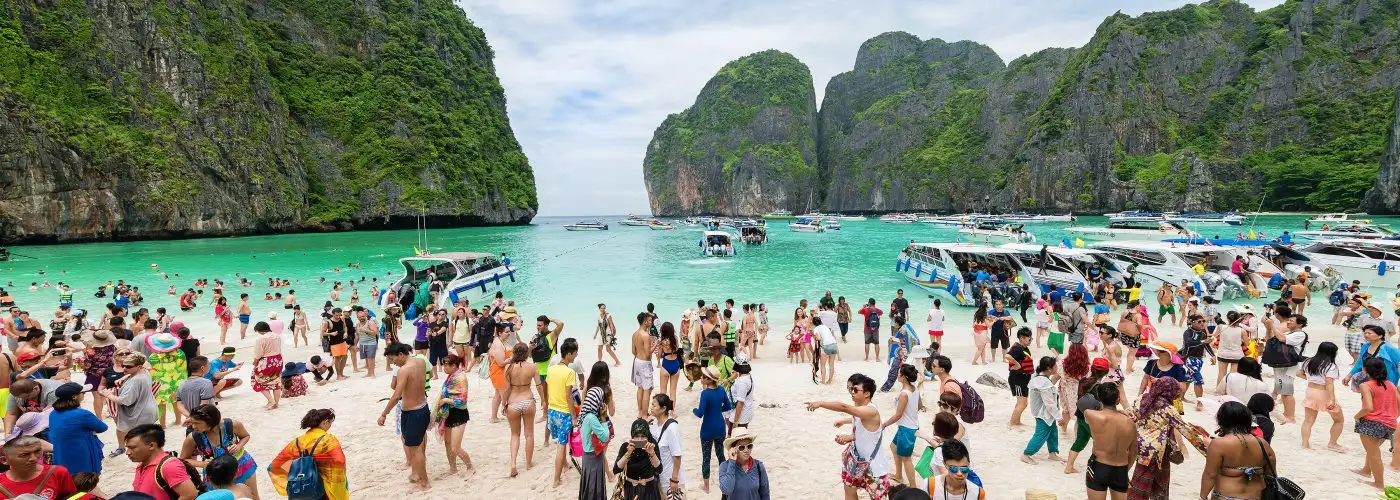Thailand officials have announced they will maintain closure of the famous Maya Bay indefinitely, after closing the beach to tourists this past June. If you’ve never heard of Maya Bay, there’s a decent chance you’ve seen it regardless—Maya Bay was the setting of the 2001 Leonardo DiCaprio film The Beach.
In fact, that movie is the main reason officials have had to shut the beach down. Tourists began flocking to Maya Bay (pictured above) after the movie came out and haven’t relented since, leading Thailand’s Department of National Parks, Wildlife and Plant Conservation to keep the park open year round. Most parks in Thailand close for about four months per year.
A decade and a half of that heavy tourist traffic took its toll. An average of 4,000 people and 2,000 boats visited the beach per day, and recent surveys of the ecosystem found devastating losses to the area’s coral reefs and marine life.
As a result, the government closed the beach in June with plans to reopen it in September. However, the beach has not recovered and will remain shut down until it does. This follows another closure earlier this year in the Philippines. In that case, infrastructure on the island of Boracay succumbed to excessive beach tourism—1.7 million visitors per year—and the entire island had to be shut down by the government, which called the area a “cesspool.”
More Closures to Come?
While these are somewhat isolated instances, the simultaneous closure of two prominent Southeast Asian beach destinations begs the question: Will this become the new normal? Tourism is a rapidly growing business, with more and more people traveling each year, particularly to places like Asia and the Pacific islands. Combine that with a changing environment, and the likelihood of rising sea levels and warming waters in our lifetime, and pollution from things like sunscreen, and it’s easy to see how the ecosystems and infrastructure around beach destinations are being overwhelmed.
And remember, closures don’t only affect tourists. Destinations like Maya Bay and Boracay Island are huge financial drivers for local citizens, and closing these beaches means cutting off people’s livelihoods in areas where there may not be solid alternatives. The Philippines’ government actually approved funding to help the local economy through the Boracay closure.
Hopefully, the closures in the Thailand and the Philippines can serve as a model of proper destination management. If both reopen with a solid plan for balancing tourism and the long-term health of the local ecosystem, other nations (including the U.S., of course) can follow suit. Closing a beach for several months is worthwhile if it makes way for decades of sustainable tourism.
More from SmarterTravel:
We hand-pick everything we recommend and select items through testing and reviews. Some products are sent to us free of charge with no incentive to offer a favorable review. We offer our unbiased opinions and do not accept compensation to review products. All items are in stock and prices are accurate at the time of publication. If you buy something through our links, we may earn a commission.
Related
Top Fares From
Today's Top Travel Deals
Brought to you by ShermansTravel
Shop and Save with Country Inns...
Patricia Magaña
 Hotel & Lodging Deals
Hotel & Lodging Deals
$229 -- Chicago: Discounted Rates and...
Francesca Miele
 Hotel & Lodging Deals
$229+
Hotel & Lodging Deals
$229+
$188 -- Honolulu: Save on Oceanview...
Abigail Lamay
 Hotel & Lodging Deals
$188+
Hotel & Lodging Deals
$188+




